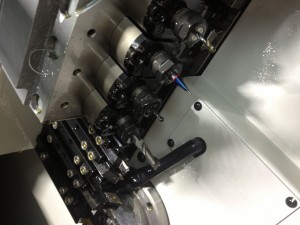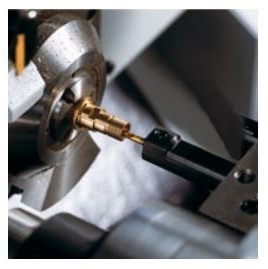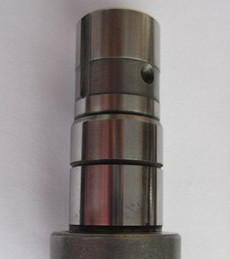
Constantly expanding area of application on the fields of industrial production, in which the parts and components being turned with automatic lathe swiss-type machines are in great increasing importance. Among the high-precision turned parts on the automatic high precision turning swiss-type lathes’ machines most commonly they are:
Market segments, which are the main recipients of high-precision turned parts lists:
 A number of reasons why multi-tasking automatic lathe machines achieves a unique advantage. Features that list this should be first and foremost: precision and high performance. These are the factors that underline the superiority of precise machining lathe machines with other paths. Highest quality with repeatability merge production makes the machining on CNC lathe machines is a specialized field among the widely available technology of machining.
A number of reasons why multi-tasking automatic lathe machines achieves a unique advantage. Features that list this should be first and foremost: precision and high performance. These are the factors that underline the superiority of precise machining lathe machines with other paths. Highest quality with repeatability merge production makes the machining on CNC lathe machines is a specialized field among the widely available technology of machining.
In today’s era of industrial production many components is made in a fully automatic process. In particular, this happens in the case of multi-axis CNC turning machines. Automatic production begins at the stage of digitalisation, CAD/CAM transfer, preparation and predefining tools, manufacturing itself, as ends on receiving complete articles and taking measurements.
Our company is in constant development in the process of automation of multitasking precision machining. New projects are that we are in continuous operations on improving our manufacturing methods.
For more information on the production of high-precision components please contact us by phone or fill in the form.
Precision CNC Turning is one of the more complex issues, due to today’s requirements and brand standards. Many branches of industry today expect tight tolerances. Our qualified staff is aware of the above and knows how crucial attention to detail is in planning and implementation of the process. The precision in CNC lathes machining includes the following:
Our vast, longitudinal CNC turning lathes multitasking operations experience allows us to undertake tasks with high quality requirements regarding the hole production process and the product. As mentioned above, CNC precision turning is, in fact, multi-task process including the following: machining, grinding, milling and other operations.
To achieve maximum precision our engineers cooperate with major tool suppliers in designing and optimizing the profile and shape of tools. We provide our expertise in creating tooling to optimize the CNC machining process.
Materials used in precision turning have to meet high quality requirements as regards both dimensional precision of the raw material and its composition. For this reason we only buy from suppliers who can offer quality products. Our understanding of precision automatic lathe turning is that of a process, the feature of which is stability and repeatability.
For more information on the production of high-precision components please contact us by phone or fill in the form.
Constantly undertaken cooperation with major suppliers of tools, we design and create a profile and shape of the tools. then its optimization-a joint action taken by our engineering resources with suppliers in order to achieve maximum precision. We can offer its contribution in the development of instrumentation to a permanent effort to optimize the process of CNC machining.
Selection of materials used for precise lathe working must offer a fairly high requirements. They relate to both dimensional precision of the raw material as well as his inhalt. Place the appropriate materials requirements, the lack of which can destroy the ability to achieve the expected precision rolling. In particular, it should be noted that the processing of precision turning lathes we understand as production details, which must be the inherent stability and repeatability of the measured characteristics of the product.
In order to obtain accurate information on the production of high-precision machine components for digital machine tools, please contact us by phone or fill out the form
Precision turning on CNC machines is associated with a number of processes occurring parallely or in the immediate aftermath. The effectiveness of the turning is spread on multiple planes affected by manufacturers of machinery, tools and process engineering and operators – the company’s production asset.
 One of the important processes from the point of view of the customer in terms of precision and efficiency in the case of turning on CNC lathe machines is cutting groove of butt off-axis and in the axis of the material. The operation of this overlap, as is the case with most machining treatments, machining tools and parameterization. Selection of tools in terms of shape geometry is especially important in this case because of the requirements to maintain precision dimensional while having to pick up chips the same as by deep drilling. However, an additional problem, is the force of off-axis which may enter the vibrations into the material then move on in the tool. In this case, continuity, depending on the material can be upset, which will then result in the final, excessive heating to the edge of the blade. Remains of the chips may also be found in the already notched Groove. Shorten life of the tools will only be the consequence.
One of the important processes from the point of view of the customer in terms of precision and efficiency in the case of turning on CNC lathe machines is cutting groove of butt off-axis and in the axis of the material. The operation of this overlap, as is the case with most machining treatments, machining tools and parameterization. Selection of tools in terms of shape geometry is especially important in this case because of the requirements to maintain precision dimensional while having to pick up chips the same as by deep drilling. However, an additional problem, is the force of off-axis which may enter the vibrations into the material then move on in the tool. In this case, continuity, depending on the material can be upset, which will then result in the final, excessive heating to the edge of the blade. Remains of the chips may also be found in the already notched Groove. Shorten life of the tools will only be the consequence.
Application of the optimization methods in the parameterization of this process is crucial and testifies to the expertise and experience of the staff in the production of precision turned components for machine tools. This topic now entered within the scope of the treatment of multitasking.
Machinability of stainless steel is by far the more difficult issue, often treated as a secondary property in view of the difficulties of its implementation. Austenitic stainless steels in comparison with steel 42CrMo4 alloy, often adopted as reference material in terms of machinability show a greater tendency to adhere, higher tendency to strengthen, low thermal conductivity and greater resistance to blade during their treatment. To prevent this adverse to apply a number of available resources. Depending on the item, which is to take for protection against work piece material adherence, as well as for the security of micro damage on the cutting edges, directly affecting the lower build quality, the more viscous the material for the production of blades, cutting and machining process is carried out by a much larger spindle speed. Optimal selection of these parameters enables you to significantly compensate for high plasticity of austenitic stainless steels, counter their strengthening during the cutting process, and improve the process of the formation of chips.
 Another essential element, significant from the point of view of the General Machinability of stainless steel is the depth of cut. It should be chosen in such a way as to minimize the risk of notch (formed as a result of the strengthened cutting layers). In addition, poss, the machine should be as soon as possible. On selected parameters of machining , and low thermal conductivity properties of austenitic stainless steel, along with a small amount of material from the twenties. That is significantly more heat comes to the edge of the cutting tool, which should be very hard. If this property is not maintained, the blade is subjected to plastic deformation. Greater wear of the tool cutting edge during the cutting of stainless steel considerably speeds up the crater wear. The resulting chips are strong, long, continuous and difficult to crack, so when you cut, you should use sharp cutting edges with a positive geometry and machining under a layer of umocnioną by work hardening. Interesting changes in the susceptibility of stainless steel machining adds to sulfur alloy. However, any change in the direction of increasing sulphur content of steel significantly reduces its resistance to corrosion. Similarly, a huge impact on the processing properties of stainless steel has nickel content. For example, high-nickel content above 20% has more than doubled lower machinability than steel with a nickel content of around 8%.
Another essential element, significant from the point of view of the General Machinability of stainless steel is the depth of cut. It should be chosen in such a way as to minimize the risk of notch (formed as a result of the strengthened cutting layers). In addition, poss, the machine should be as soon as possible. On selected parameters of machining , and low thermal conductivity properties of austenitic stainless steel, along with a small amount of material from the twenties. That is significantly more heat comes to the edge of the cutting tool, which should be very hard. If this property is not maintained, the blade is subjected to plastic deformation. Greater wear of the tool cutting edge during the cutting of stainless steel considerably speeds up the crater wear. The resulting chips are strong, long, continuous and difficult to crack, so when you cut, you should use sharp cutting edges with a positive geometry and machining under a layer of umocnioną by work hardening. Interesting changes in the susceptibility of stainless steel machining adds to sulfur alloy. However, any change in the direction of increasing sulphur content of steel significantly reduces its resistance to corrosion. Similarly, a huge impact on the processing properties of stainless steel has nickel content. For example, high-nickel content above 20% has more than doubled lower machinability than steel with a nickel content of around 8%.